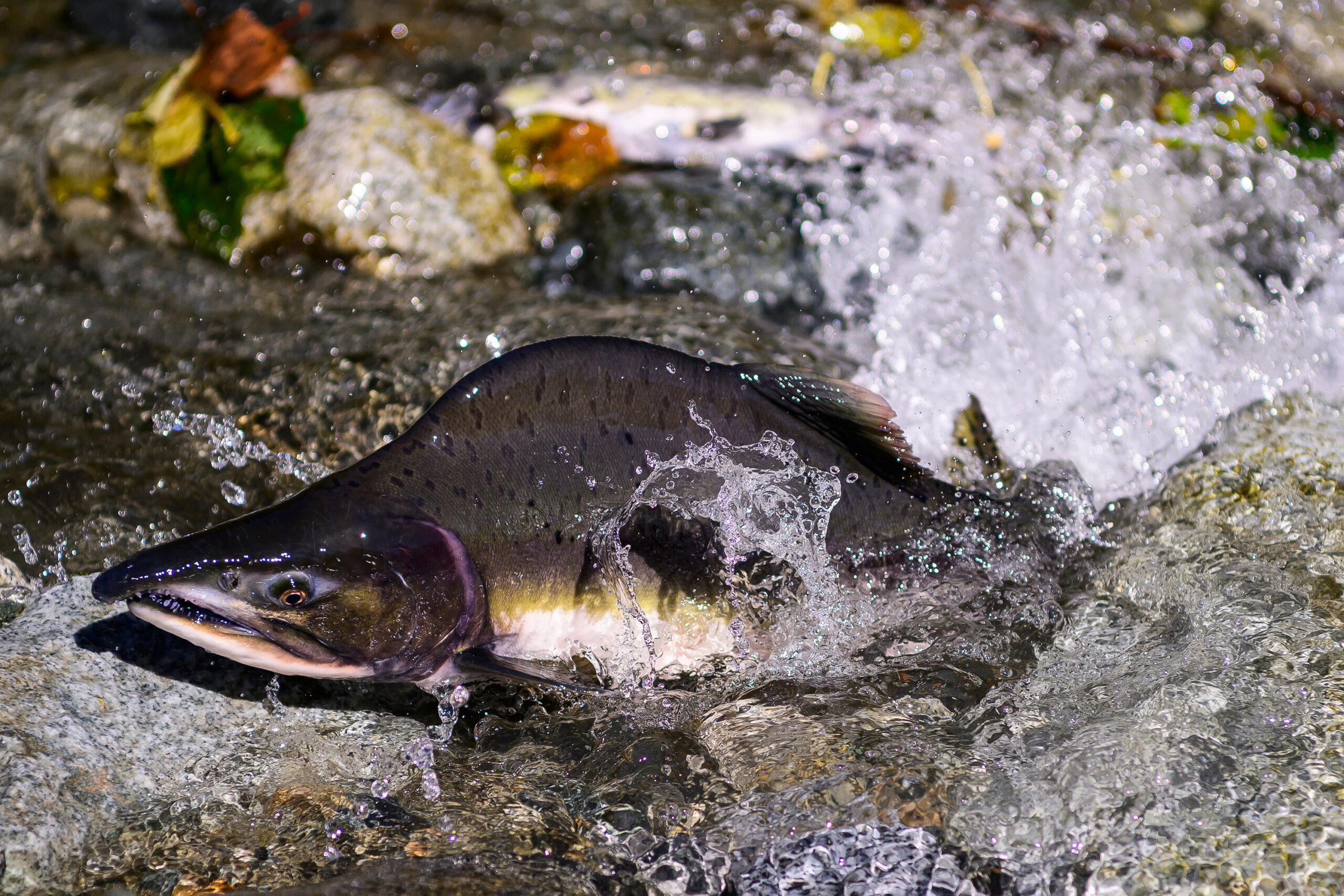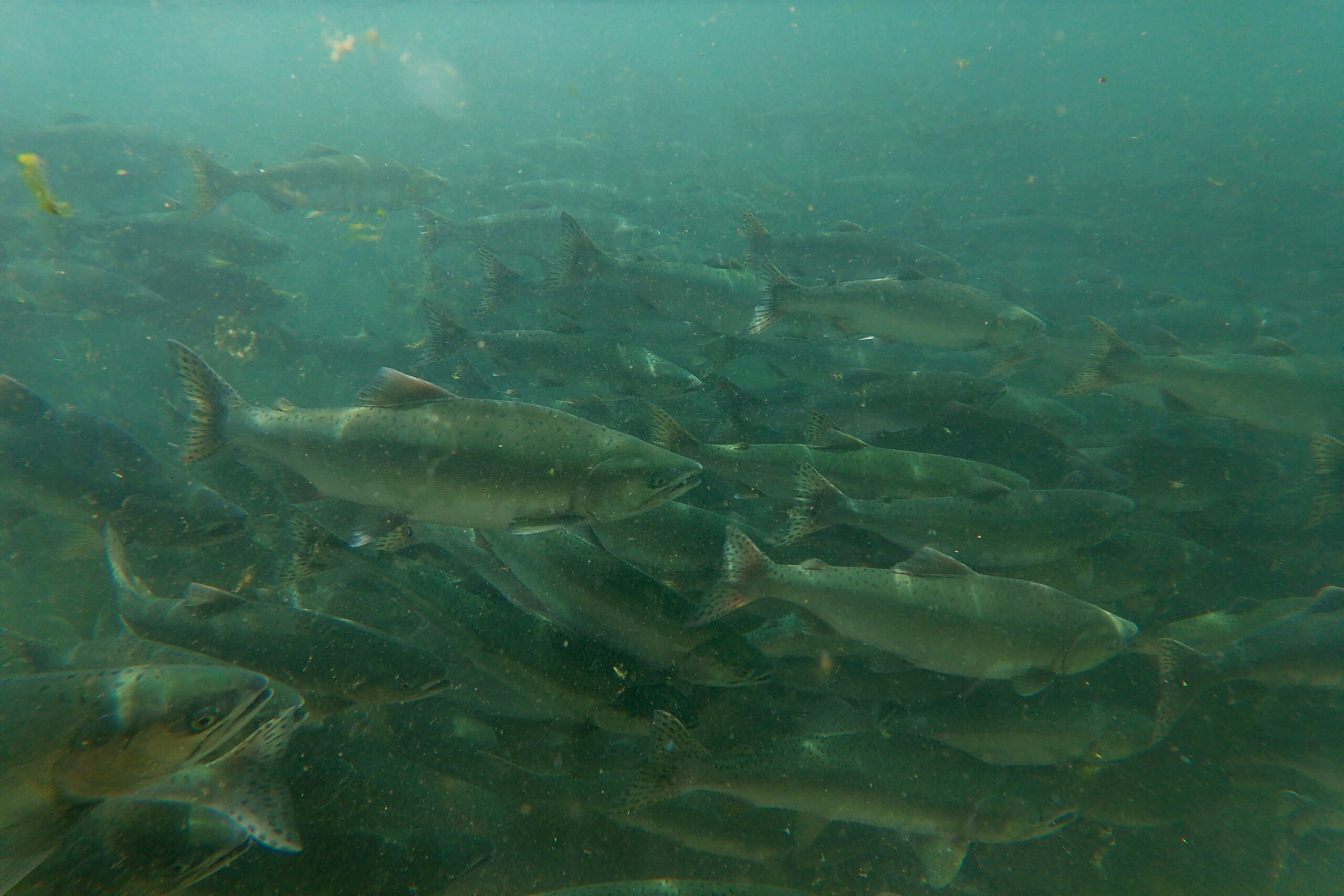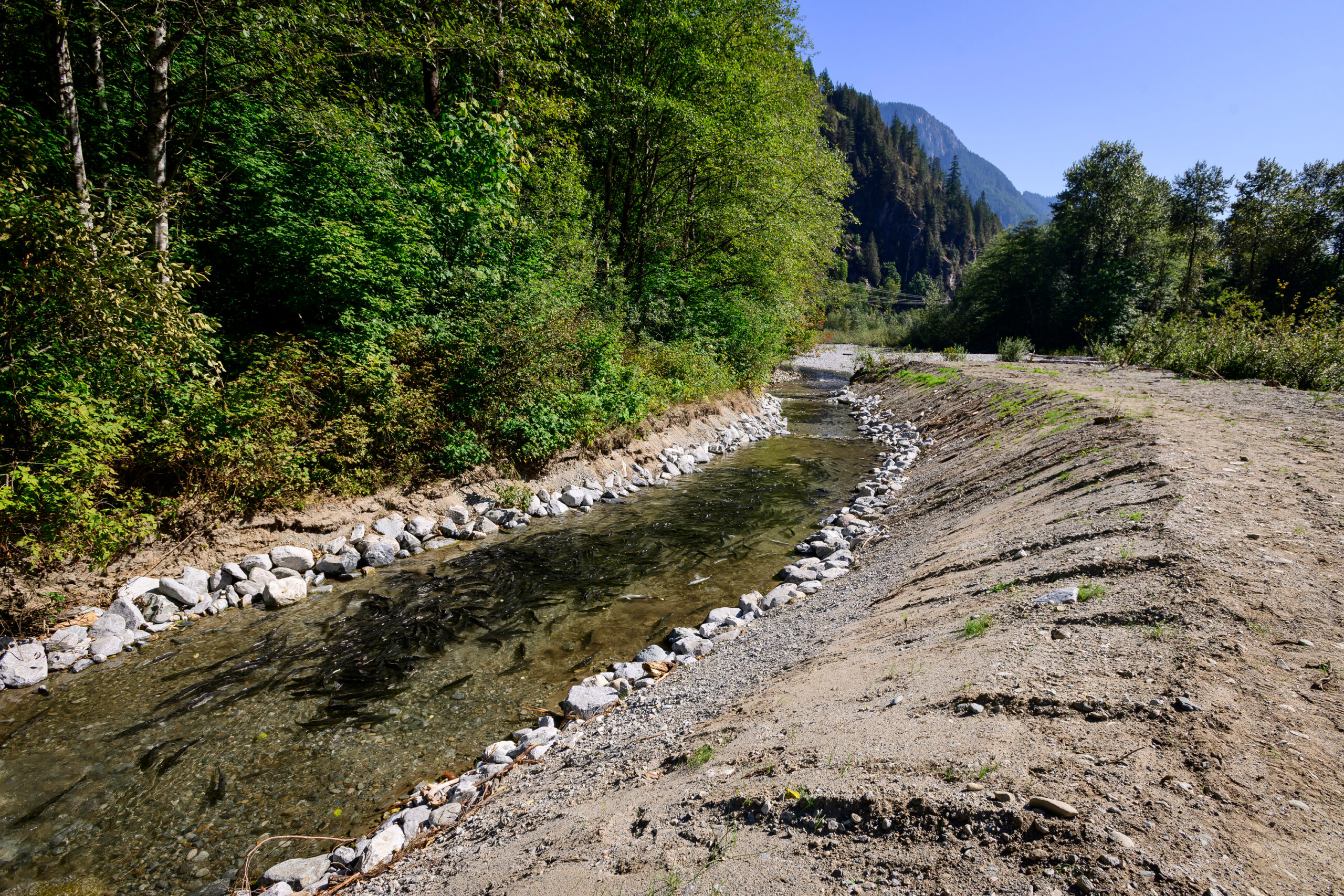
Water determines the Great Lakes Region’s economic future
Climate change, geopolitics and business opportunities power a blue economy
This story is part of Nourish, a series about how First Nations are fuelling their people with sustainably harvested, healthy and culturally safe foods amid a changing climate
Tens of thousands of pink salmon were desperate for a way through a gravel bar as water levels in xʔəl̓ilwətaʔɬ, the Indian River, dropped to dangerous lows last week. They were stranded and quickly running out of oxygen.
“They’re suffocating,” Graham Nicholas, a senior environmental specialist with səlilwətaɬ (Tsleil-Waututh Nation) told The Narwhal last week. “There’s too many fish in too little water.”
Rivers across B.C. are showing the strain of a long, hot, dry summer and what the provincial government is referring to as a historic drought. Water levels are low, temperatures are high and in some areas there’s very little rain in the forecast. Twenty-one of B.C.’s thirty-four water basins are locked in a level five drought, the most extreme category of drought. For the millions of salmon, making the arduous journey upriver to spawn, conditions are dire.
In xʔəl̓ilwətaʔɬ, about 5,000 fish were dying a day at the worst of it, says Charlie George, a natural resource technician and Tsleil-Waututh Nation member. And, as their bodies decayed they took up more of the already limited supply of oxygen.
“We knew it could get really bad really fast if we didn’t do anything,” Charlie says.
As Tsleil-Waututh Nation worked to clear a path through the blockage, a few thousand salmon found refuge in a small channel the nation restored just this summer as part of a broader effort to rehabilitate a watershed degraded by historic logging. At the height of a crisis, this small restoration project offered a glimmer of hope.




Across B.C., industrial logging, mining and other development has degraded salmon habitat, making already struggling populations more vulnerable to the impacts of heat waves, drought and torrential rains. As climate change drives these extreme weather events, the work communities are doing to restore damaged ecosystems is more important than ever.
xʔəl̓ilwətaʔɬ hasn’t seen the same degree of impact as other parts of Tsleil-Waututh Nation territory, which stretches across much of the area known today as Metro Vancouver. There, heavy urban and industrial development mean Tsleil-Waututh people can’t regularly harvest clams from Burrard Inlet, or hunt duck and deer on lands that are now covered in steel and concrete.
In that context the Indian River watershed is vital to Tsleil-Waututh Nation’s ability to practice its traditional ways, says Michelle George, cultural technical specialist with the nation’s Treaty, Lands and Resources Department.

“My family would go up every season and set up camp and do their fishing, harvesting and preservation practices,” she says. “The rivers were so abundant.”
But “forestry has heavily impacted the valley,” she says. “For the last couple of decades, we haven’t been practicing at all.”
By restoring salmon habitat, the nation hopes Tsleil-Waututh people will be able to harvest food from the river once again.
It’s just after 6 a.m. on Aug. 10, and the sun is still hiding behind the mountains, as Charlie steers the boat away from the dock at the Deep Cove marina.
We’re headed up the north arm of Burrard Inlet — səl̓ilw̓ət as it’s known in the hən̓q̓əmin̓əm̓ language — to the mouth of the Indian River. The pink salmon run is well underway, with hundreds of thousands of salmon returning from two years in the ocean to the river where their lives began.


Tsleil-Waututh Nation once had a village, called Inlailawatash, near the river mouth, which fans into a wide estuary as freshwater mixes with the salty sea. They’d fish for pink and chum salmon and dry it in smokehouses to eat over winter.
“My ancestors said [the fish] were so thick there that you could walk across the backs and never touch water,” Michelle says.
Today, the river is closed to salmon fishing to let populations recover from declines wrought by logging and industrial projects, including a hydroelectric line and natural gas pipeline that run through the watershed.
But there’s hope that one day, not too far from now, the nation will once again have smoke houses in xʔəl̓ilwətaʔɬ where Tsleil-Waututh people will be able to harvest and preserve salmon.
“Even just something small-scale like that would be pretty cool,” Charlie says. “It’d probably be pretty hard to get me out of here.”

On shore, Nicholas unlocks a shipping container and backs out the truck that will carry us up the logging road to the restoration site.
After a bumpy ride, we hop out and wind our way past an idle excavator, through the forest and out along a berm that helps protect the spawning stream from the powerful mainstem of the river. The berm has been shorn up with debris dug out of the small channel over the last two weeks.
When a heavy storm ripped through the area in 2017 it triggered a landslide that tore up part of the mountain, choking prime spawning habitat in its path.


Decades of logging and roadbuilding have worsened the natural instability of the steep mountainsides that flank the river.
“In a perfect world, what you’d want to do is start working from the top down,” Nicholas says.
Charlie and Nicholas are also concerned about the risks to the watershed from a new FortisBC natural gas pipeline that will feed the Woodfibre LNG plant in Squamish, B.C.
With work set to start on the pipeline this year, Nicholas says this could be the last stream Tsleil-Waututh restores for some time. “It will be incredibly busy up here,” he says, which could make it difficult for the nation to move forward with its own projects.
Restoration work on the small channel hasn’t started yet this morning. The water runs clear and — because it’s fed by groundwater — cold. It’s “like refrigerated water,” Nicholas says. And it can “noticeably” cool the main stem of the river, Charlie adds.
In the midst of the climate crisis, streams like this can help build resilience to hotter, drier summers.
They’re so important for buffering the impacts of drought, says Jane Pendray, the manager of the climate adaptation program at the Pacific Salmon Foundation.
As river flows decline, water temperatures can reach dangerous levels for salmon, she explained. If water levels get too low, they can leave salmon stranded. Both effects can be lethal.
But groundwater streams, with their consistent flows and cool water, can offer critical reprieve.



The steep banks of the channel are bare for the moment, but the crew plans to stake cuttings from nearby willow trees to spur new growth. It won’t be too long before vine maples, salmonberries, cottonwoods, alders and spruce trees take hold, adding stability to the bank.
The hope is that one day this little waterway will offer habitat similar to the “gold standard” spawning channel we’re headed to next.
We pull on our waders and clamber down the bank into the river. Illegal fishing is a big problem here. “We’ve seen fish get poached all the time,” Charlie says as we trudge through the water. People drive down the logging road from Squamish — sometimes right onto the riverbed to camp or do donuts. The nation put up barriers at popular access points to try to stop it, but it’s frustrating, he says.
We climb up and over the opposite bank, into a cool, groundwater channel built in the late 1980s. It’s exactly the kind of spawning habitat chum prefer, with its gravel bottom, fallen logs and trees stretching out over the stream like leafy umbrellas.
Juvenile coho like it too. Unlike chum, which head out to the ocean soon after hatching, coho will spend their first year in little forested waterways like this. The small fry are all over the place in this stream. Many hide under roots and rocks extending from the banks, but a handful of curious characters investigate our boots when we stop to talk.

As we walk downstream, Charlie spots hoof prints in the gravel. Elk have travelled through here and not long before us: their musky scent still lingers in the air.
We come to a bend in the creek, where the 2017 landslide came crashing into the stream, ripping out trees and clogging 120 metres or more of the channel with thick, impenetrable muck. For five years, salmon were cut-off from the beautiful habitat we’d just passed through.
Last year, Tsleil-Waututh Nation led a restoration project to reconnect this spawning habitat to the main river. It took two excavators almost a week just to clear the debris, longer to rebuild a channel to the river.

Though not yet as lush as the habitat we’ve just come from, Charlie and Nicholas point out all the good understory plants — the salmonberries, thimbleberries, elderberries, ferns, willows — already taking hold on the banks after just one growing season.
With so much unstable terrain in the mountains, Tsleil-Waututh Nation doesn’t know how long these channels might have before another landslide or some other extreme event takes them out again.
Salmon need access to these channels now, Nicholas says, so “we’re not just going to wait around.”
But “we’re basically just doing damage control a lot of the time,” Charlie says.
Until the logging impacts on the mountainsides are addressed, salmon habitat will continue to be at higher risk from rainstorms, drought and other climate extremes.
Fast forward a month and roughly 300-metres of xʔəl̓ilwətaʔɬ has dried up under extreme drought conditions. Here too, past logging may have played a role. When old logging roads fail, sediment and debris from those slides can end up in the river, creating high spots that dry up more quickly during a drought.
“The river is completely jam-packed with hundreds of thousands of fish that are essentially stuck,” Nicholas tells me over the phone in mid-September.
“It’s pretty scary to be honest,” he says. There’s already potential for a mass die off and chum will start returning to the river in the next several weeks.

The Indian River isn’t alone.
Most of the province is experiencing severe drought right now. A warm spring saw the snowpack melt “extremely quickly,” meaning rivers lost that fresh inflow from snow much earlier than normal, David Campbell, the head of B.C.’s River Forecast Centre, explains.
After a dry summer, groundwater is “critical,” he says. It’s really what’s feeding the rivers right now.
Downstream of the blockage in xʔəl̓ilwətaʔɬ, salmon still have access to the small stream Tsleil-Waututh Nation restored this summer. It is a much needed source of fresh, cool water.


Although pink salmon typically spawn in the main stem of the river, this year a few thousand have pushed into this newly restored channel.
It “was good timing,” Nicholas says of the project. “There’s just so many fish trying to spawn and there’s not enough space,” he says. “They’re just spawning where they can.”
But upriver, Charlie estimates about 50,000 salmon were stuck below the gravel bar, with nowhere to go. “The oxygen there was plummeting,” he says.


With emergency funding from the Pacific Salmon Foundation, Tsleil-Waututh Nation and Fisheries and Oceans Canada used an excavator to dig channels through the gravel bar to restore the river’s flow.
As the salmon felt that first flush of fresh water, Charlie says “it’s like they suddenly all woke up and they were just frantic to get upstream.”
Thousands of salmon have now made it farther up the river. “It’ll take a few days for us to really see the effects,” he says, “but right now fish are doing a lot better.”
What’s needed now is rain. “The little bit of rain that we have been getting, it’s great, but it’s just not enough,” Nicholas says. “The whole watershed is just this dry sponge.”
“We need a good, consistent amount of rain for it to actually push the river up,” he says. “The clock is ticking.”

The Narwhal’s series, Nourish, is made possible with support from the Real Estate Foundation of BC. As per our editorial independence policy, no foundation or outside organization has editorial input into our stories.
